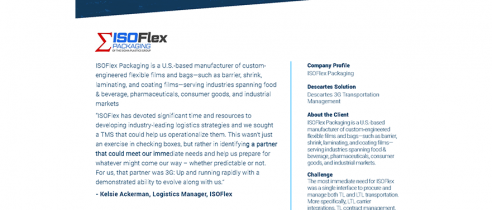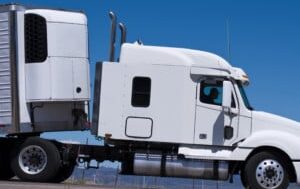International trade has existed for centuries, but there have always been limitations. When it comes to transporting perishable goods that must be kept cool, the challenges have been formidable. In the 1800s we sought to overcome these difficulties by placing ice and salt underneath temperature-sensitive goods during shipping. Often though, many of these goods would arrive spoiled, resulting in major losses. By the 1900s, developments in refrigerated freight made it possible to transport goods over longer distances, with fewer losses, giving rise to cold chain logistics (or refrigerated logistics). What began with refrigerated (or reefer) train cars and cargo ships has exploded onto our highways with refrigerated trucks numbering in the millions.
Since then, the industry has grown to over 36 million loads of refrigerated products shipped each year. It seems this growth is likely to continue, as refrigerated containers, reefer ships, and other logistics software such as Transportation Management Systems software, improve. But even with these advances, challenges continue to remain, and restrictions are becoming increasingly difficult to navigate. Here’s what you need to know about refrigerated cargo transportation and TMS freight logistics.
Looking for real-time TMS tracking and logistics help for your business? The Transportation Management Systems software from 3Gtms helps you plan your shipments, maintain visibility, shorten the supply chain, and increase your customer satisfaction. Find out why 3Gtms is the TMS solution preferred by shippers, brokers, and third-party logistics providers.
What is Transport Refrigeration?
Refrigerated trailers or cargo ships, often referred to as a “reefer ships”, allow for the transportation of temperature-sensitive goods such as meat, seafood, produce, chemicals, and pharmaceuticals. These goods must be kept at appropriate temperatures to avoid spoilage. For many of these goods, refrigeration is absolutely essential, as they could not be transported without it. This is why the specifications for shipping such items are stringent. You may wonder how these refrigerated transport methods work. For most, the technology is similar to your fridge and freezer at home, or the air conditioning unit in your car. Rather than producing cold, the units remove heat from an enclosed space. This is accomplished by an evaporator, compressor, and condenser system along with a gas or liquid coolant. Unfortunately, there are a number of problems that can cause these units to work inefficiently. First, leaks are common problems in trucks, ships, and train cars that are constantly exposed to the elements and rough conditions. Second, each time the doors to the cooled compartment are opened, some heat gets in. This is particularly a problem for delivery vehicles which may have to make several stops on their routes. Finally, some small amount of heat can be produced by the products themselves, even after they’ve been initially cooled.Shipping & Cargo Requirements
If you’re shipping perishable goods, either by land or sea, then expect a great deal of requirements and regulations. With the economic development of nations across the globe, and increased awareness among consumers who now favor perishable items in their diet, safety and health standards are more important than ever. The implementation of the Food Safety Modernization Act only shows that these regulations are going to continue to affect shippers and carriers. Here are some of the requirements for refrigerated shipping that you need to consider, outlined by the GCCA (Global Cold Chain Alliance):-
- Proper refrigeration equipment design and maintenance
-
- Type of transportation
-
- Food safety procedures
-
- Required temperatures for goods
-
- Separation of goods
-
- Sanitation standards
-
- Trailer, container, and/or reefer requirements
-
- Pre-loading considerations
-
- Multi-temperature refrigeration
-
- Pre-cooling
-
- Packing considerations and requirements
-
- Airflow/ ventilation
-
- Processes of unloading
-
- Time between shipping methods
-
- Compliance requirements & reporting
-
- Carbon dioxide limits (especially for items like fruits)
-
- USDA requirements such as insertion of temperature probes to avoid insects and maintain specified limits
-
- Documentation (especially important in the case of a claim
Shipping & Cooling Systems
There are several methods for shipping refrigerated goods. The most common is using reefer ships. Reefer ships are container ships that carry only refrigerated containers. They vary greatly from regular container ships in size, design, electrical distribution, power generation, and equipment. The special design of these ships makes them better suited for inclement weather since they are enclosed, sealed, and insulated. Because of their self-contained systems, they can often bypass cold storage upon arriving at their destination. Reefer containers also have systems that cool the air off-put by the unit itself, in addition to their water cooling systems. This is used when a reefer shipping container is transported on a regular freighter, with the container is stored below deck where there is likely no proper ventilation. Total loss refrigeration An alternative to the typical mechanical refrigeration units discussed above, total loss refrigeration is a simpler solution used in some cases. During short journeys, frozen carbon dioxide or liquid nitrogen can be employed. It slowly evaporates, cools the entire container, and is vented out. This can last up to 30 days of transit. While this method has fewer maintenance costs, it’s impractical for most refrigerated transport uses. Controlled atmosphere technology Due to recent restrictions, new technologies are now focused on reducing greenhouse gasses as well as the cost-reducing potential of more efficient cooling systems. Controlled atmosphere technology is a system in which the concentrations of oxygen, carbon dioxide, and nitrogen are carefully managed. This can help to delay ripening, aging, and decay as well as to improve the quality and taste of their goods. This technology is a step in the right direction, but there are still many challenges in the industry.Challenges of Cold Chain Logistics
While the above is just a skim of the requirements to transport refrigerated goods, it at least touches on the complexity of cold chain logistics and the importance of supporting software to help manage it. However, compliance and regulations aren’t the only challenges. There are several other problems that refrigerated transportation can encounter through the course of daily operations.Not Enough Specialized Transport Carriers
Competition has whittled down the number of refrigerated transport companies with reefer ships from twenty at the start of the millennium to a current total of eight worldwide. Diversified containerships that can hold reefer containers provide a faster return on investment.Refrigeration Intricacies
Fruit and meat are the most common items transported by reefer ships, and always have been. But there is much more diversity in products transported today, and all have different requirements for transportation. Temperature control, ventilation, humidity, packaging, are all important and different for each item. Some items, like tomatoes and potatoes, require changes to the temperature while still in transit. One solution to this has been pre-programmed multi-temperature systems, but as there are fewer companies offering refrigerated transport, this feature may be more difficult to come by.Losses & Insurance Claims
For shipping companies who transport refrigerated goods, spoilage and loss is a real issue. If anything goes wrong with the climate control system in transport, entire loads can be lost, leading to huge expenses for the company. Due to the nature of perishable and temperature-sensitive items, many carriers do not cover them in their freight insurance policies. Even when they do, their liability is often limited.Solutions for Shippers & Logistics Managers
While refrigerated transport and cargo logistics are complicated and costly, there are solutions to simplify, mitigate risk, and reduce costs. By following these guidelines, shippers and logistics managers can safely transport climate-controlled loads while avoiding most of the avoidable causes of loss and spoilage. Proper cooling and packaging The first way to avoid losses in transit is to prepare goods for shipment properly. In the case of refrigerated freight, especially for small shippers and e-commerce, products must be pre-cooled to specifications. Reefer trailers and containers can hold temperatures, but they aren’t designed to lower them. If it must cool down the packages to keep them at temperature, the container or trailer may experience strain and result in breakdown or failure. This is the reason the first step in cold chain logistics is the cooling system used to bring goods to the proper temperature before shipment. Next, you’ll need to ensure that goods are stored in a climate-controlled facility until they are loaded onto a truck, ship, or plane. Just a few hours on the loading dock can cause some goods to warm up, leading to spoilage in transit. Finally, be certain to use proper packaging materials to keep warm air out of your goods, such as Styrofoam or insulated lining. Documentation Proper documentation is essential in any shipping logistics system, but even more so in the case of refrigerated or climate-controlled goods. If you ever have to file a claim, having the right documents are more likely to yield an accepted claim. You will need any receipts, records of inspection, pictures, videos from loading or unloading, documentation of any disputes, original order forms, appraisals, etc. Keeping the proper paperwork and documentation in order can mean the difference between an accepted claim and a rejection. Software Any type of supply chain management is complicated, but cold chain transportation adds further levels of complexity. Employing the right software, such as TMS, will allow you to centralize all of your data, keep track of shipments in real-time, and receive strategies for improvement. Real-time freight tracking is becoming increasingly important in the transportation of refrigerated goods, as they are often integrated with temperature monitoring. These systems can tell when the door to the trailer has been opened, or when the shipment has halted, and even if or when the temperature changes in the container. This allows the shipper or carrier to take action before the shipment is compromised and also helps to stay compliant to shipping regulations.Looking for real-time TMS tracking and logistics help for your business? The Transportation Management Systems software from 3Gtms helps you plan your shipments, maintain visibility, shorten the supply chain, and increase your customer satisfaction. Find out why 3Gtms is the TMS solution preferred by shippers, brokers, and third-party logistics providers.








